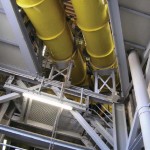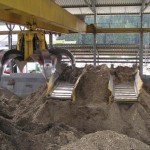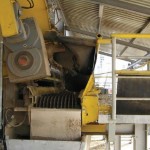To guarantee trouble-free operation of the power plant, it is absolutely necessary to use an optimally designed and regulated fuel conveyance line. The fuel which has been conditioned or is delivered with the correct size is collected in the roofed fuel collection hall and transported by a crane to the so-called metering conveyors.
The cranes work fully automatic and each crane has a capacity of 10 cubic metres.
The metered-out fuel volume passes a disc shifter that consists of a number of rotating steel discs and filters any disturbing matter and too long wood chips out of the fuel stream.
As another protective device before the fuel gets into the boiler house, a rotating electromagnet removes iron components.
Non-ferrous metals such as aluminium are removed from the fuel stream by a non-ferrous metal separator and in the further course of the process recycled separately from the ferrous metals.
The fuel stream which is then mainly rid of  disturbing materials is subsequently divided in the boiler house and routed in two separate lines.
disturbing materials is subsequently divided in the boiler house and routed in two separate lines.
Two conveyor/metering screws which are independent of each other then guide the respective lines to the boiler from two sides via a weighing belt. The two conveyor lines are designed to be able to transport 100% of the fuel necessary for combustion if one of the lines should fail.

